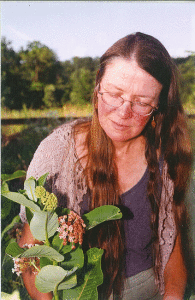“Amazing Insect Migrators”
by Christine Maccabee
Most commonly, we think of migration as a ritual birds and Monarch butterflies undertake, but a surprising variety of insects also migrate hundreds, even thousands, of miles to spend winters in warmer habitats. Like most people, I was unaware of these amazing aeronautical feats until I read an article about it in the National Wildlife Federation magazine, which I receive due to my membership in this great conservation organization (to read the entire article and see photos of these heroic insects, look up its August-September issue).
In the article, I learned that two of my favorite and regular visitors to our flowering plants here in North America are the painted lady and the common buckeye, which are both in the same family of brush-footed butterflies. They are considered inconsistent migrants, as some die with early onset of cold weather. In more southern states where the weather is a bit warmer, they can successfully winter over in log piles, old sheds, and loose bark on trees. However, brave painted lady butterflies (which weigh less than a paperclip), flying south from frigid northern climates, such as Canada, have been detected on radar to be traveling together in massive clusters of thousands!
Reading on, I learned that the large milkweed bug, which we commonly see on milkweed seed pods and which have the same coloration as monarchs, develop wings as they mature and fly south to Mexico in the autumn. In the spring, their progeny return north following the emergence of milkweed, along a pathway similar to the Monarchs. Such amazing journeys earth’s small, beautiful, orange and black winged insects travel in order to survive treacheries of weather. I cannot help seeing parallels between them and our southern human neighbors migrating north in order to escape danger, all of us together enduring impediments such as wind and rain of hurricanes, hunger and fatigue, even other human predators. In the case of insects, unfortunately many will die from the inordinate amount of pesticides and herbicides we use on our fields to grow our food.
The champion of insect migrants is the Wandering Glider which is a small dragonfly or damselfly which I see frequently around my pond and fields during the summer; they are busy all day feeding on airborne plankton and smaller flying insects such as gnats and mosquitoes. This amazing insect has been known to cover 11,000 miles in the Eastern Hemisphere, 2,200 miles of that while crossing the Indian Ocean. It is the only transoceanic insect migrant. Are you blown away yet?!
There is not yet, and may never be, a complete record of all the insects which migrate, but researchers have compiled a list of at least 71 species ranging from butterflies and moths to grasshoppers and even some beetles. So far, butterflies are the largest group at 27 species, followed by 20 species of moths and 15 different dragonflies, according to entomologist Mike Quinn.
The diversity of lifeforms on our planet is astounding and all of them require natural habitat and have patterns of behavior which we as human caretakers/stewards should not only be amazed about, but also should protect to the best of our abilities. So, as I continue my research and work at providing habitat on my own property, I hope you too will join me and many others in this great, important effort to preserve precious life on our planet.
Go to www.nwf.org/nw and become a member in order to help their efforts and to receive their great magazine.

 Gardening for Wildlife
Gardening for Wildlife